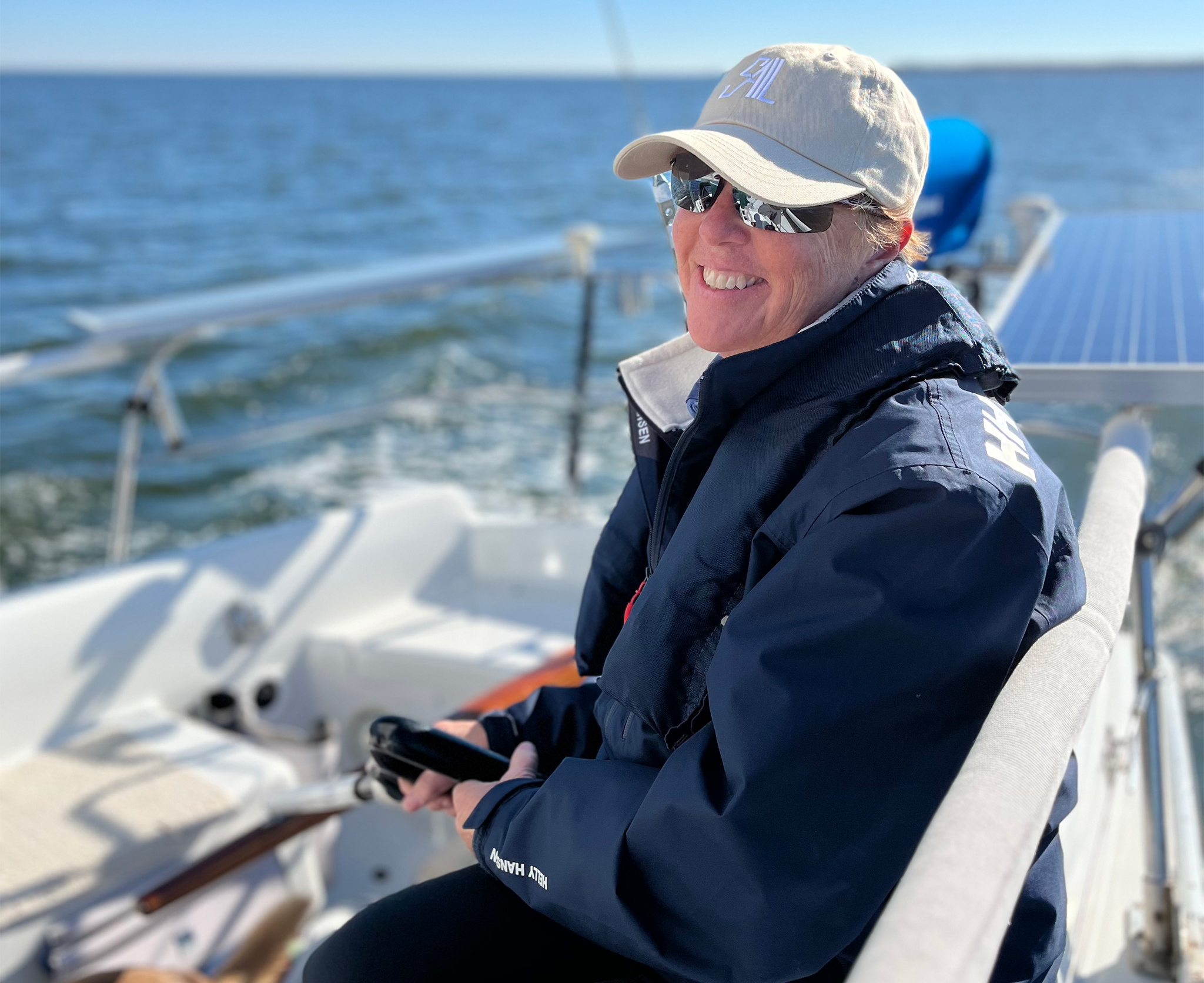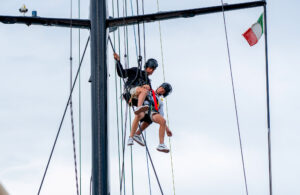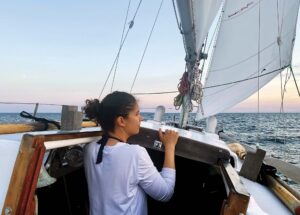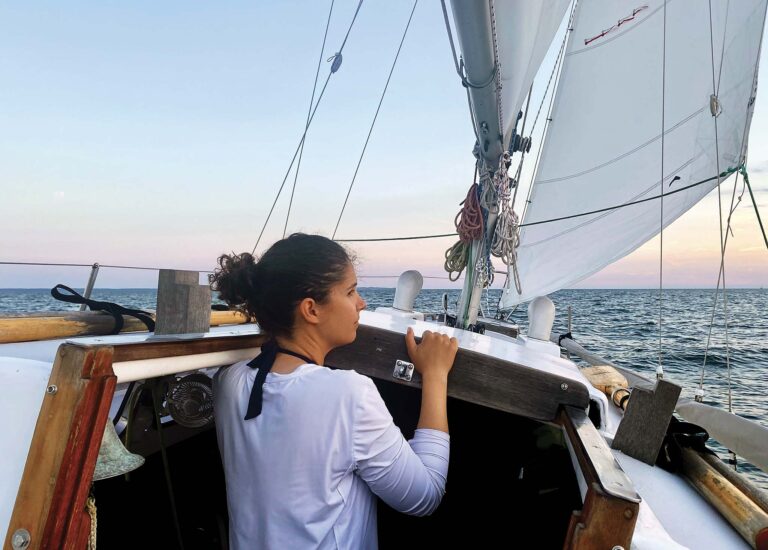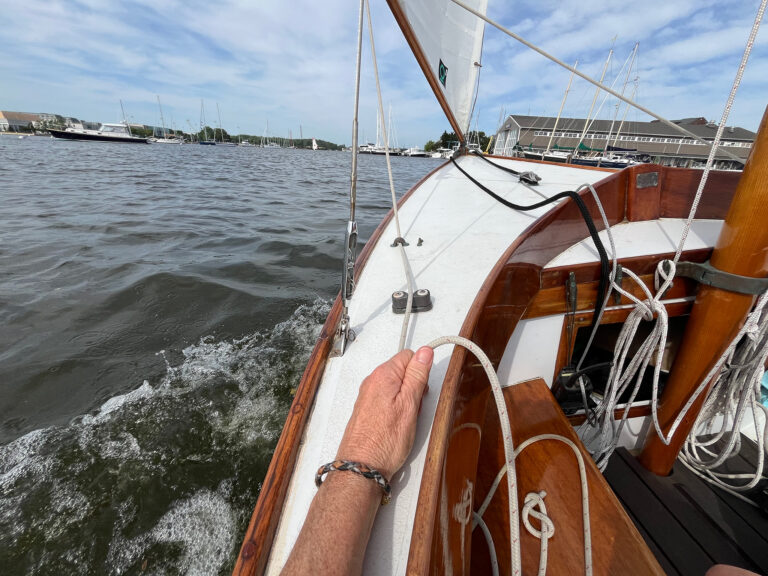In March, the Cruising Club of America honored Carter Bacon of Cambridge, Massachusetts, with its Rod Stephens Seamanship Trophy for his “his meritorious handling of the sinking of his classic 50-foot K. Aage Nielsen sloop Solution during the return sail after the 2024 Newport Bermuda Race.
“Abandoning one’s 60-year-old yacht after 24 years and numerous voyages, including several races to Bermuda and a transatlantic crossing, is a difficult decision to make—comparable to losing a family member,” the CCA said in a media release. “Bacon put his crew’s safety first and foremost, which he is quick to say was an easy decision for him. For what is all too often a dangerous and chaotic event, in a carefully orchestrated manner and with expert support from the U.S. Coast Guard, Bacon and his crew abandoned Solution 200 miles off Cape Cod, bringing everyone home safely.”
Six months after the sinking, Carter spoke with me about his experience and what he felt were the key takeaways that could advance safety at sea for other sailors. Of these, one was foremost: “When you figure out that you’re probably going to lose your boat, don’t hesitate to shift gears. Don’t let your brain go on about how, ‘If I just take another hour and do these other things, my chances of saving the boat are going to go up.’ Because you’re going to lose that hour, two, or 10, or whatever the number is.”

At that point, he says, the priority must be shifted to focus on rescue—itself a time consuming and meticulous task—from communications to liferaft preparation.
“What have you got in the scale? On one side, you’ve got the lives of yourself and your crew, and on the other side you’ve got your boat that you love. And the only reason we would gamble is because we really want to save this beautiful boat. It’s such a great boat, it’s such a wonderful boat, it is. It’s not worth risking a human life to save a beautiful thing.”
The Boat
Built in 1963 by Paul Luke of East Boothbay, Maine, Solution was designed and built for offshore racing, with 2 x 2 laminated 8-ply white oak frames, double planking of 7/8 mahogany over 3/8 cedar, bronze floor timbers and reinforcing members, and a plywood deck with fiberglass sheathing. Carter has owned her since 2000, and he and the wooden boat experts at Rockport Marine kept her in top condition, annually inspecting and replacing any questionable structural areas.
Primarily, Solution’s long cruising and racing career with Carter has been uneventful and successful, although in 2015, during a transatlantic race from Newport, Rhode Island, to Cowes, England, they damaged the rudder in a severe broach. He and his crew used drogues to control and steer the boat to the Azores, where he had the rudder repaired. He then sailed her to Ireland and spent three summers cruising with his wife in Northern Europe.
Last year’s Bermuda Race was his fifth on Solution. In the 2008 race, the fleet was beating hard to weather for days, including a violent full day in the Gulf Stream. Solution began to leak, and they could not determine the cause, so they turned around and ran with the wind, which slowed the leaking. The yard later found that a butt block, which covers the joint between two planks, had been omitted in a replanked section, and the water pressure from the pounding was squeezing water between this small section of the planking.
The Bermuda Return
Solution completed last year’s Bermuda Race uneventfully in four days. On June 29, Carter headed back home with three others—his 37-year-old daughter, Libby, an experienced crewmate who’s sailed many miles aboard Solution, and two experienced but new-to-him crew, Louise and Clive Crooks. His regular navigator, Jim Gabriel, provided up-to-the-minute routing and weather information via satellite comms with IridiumGO. The passage was routine, if at times breezy and bumpy—nothing they didn’t expect, he says. On July 1, Clive and Louise went off watch below, and Clive slipped and hit his head. Though he said he was OK at the time, they determined later that he probably suffered a concussion.
The boat continued to handle the conditions well, although by July 2 they were in a northbound meander of the Gulf Stream, and when the strong winds that had been pushing them clocked into the west, the ride got rougher. They started the engine to assist and were still making good time over the bottom in the northerly meander. At 3:30 a.m., the engine shut down; the cause was likely sediment stirred up from the tanks. “In a calm harbor with no rolling I could replace the fuel filter and get the engine back online in 20 minutes,” Carter wrote in a post for the Newport Bermuda Race website. “In a choppy sea, getting the engine restarted would be an almost impossible challenge. It would have to wait.”
He also determined that given the engine situation and a predicted northerly wind shift with increasing wind speeds as they approached the edge of the Stream, it would be safer to head for Cape Cod, 230 nautical miles away, than to try to hold the more northerly course to Rockport. With Clive doing a good job at the helm in “crashing seas,” Carter went forward and set a small staysail to better balance the boat with the double-reefed main. Then Clive went below to rest, and Carter took the helm. At that point, he says, they were at the wall of the Gulf Stream, that zone where the warm current is fastest against the colder Atlantic water. The wind-against-current seas were stacked up and violent.
“I was a little surprised by the ferocity of the pounding,” Carter says. “For instance, that Bermuda race in ’08 when we were in the Stream with adverse winds and current behind us, there was pounding, it was 30, gusting to 40. It was windier, but the pounding was nowhere near as bad as what I experienced just at the end of this.” But he noted that Solution was sailing well regardless: “We were feathering it. We were certainly controlling the boat.”
In the midst of this, the boat landed several times with a hard “bang,” indicating she had landed more on her side than her bottom. At about 7:30 a.m., two of these “bangs” in a row “were the loudest and most bone-jarring I have ever experienced on any boat. I now believe that these hard landings opened a seam in Solution’s hull.”
Almost right after this, they were out of the Stream. The waves spread out and became easier to sail through, although the wind began increasing as predicted, 26 gusting 30, and he dropped the main. “We were sailing comfortably and with plenty of speed with just a staysail, something Solution had done on a number of previous passages in similar conditions. We were just fetching Cape Cod.”
With the boat stabilized and sailing well, he handed off the helm to Libby and went below.
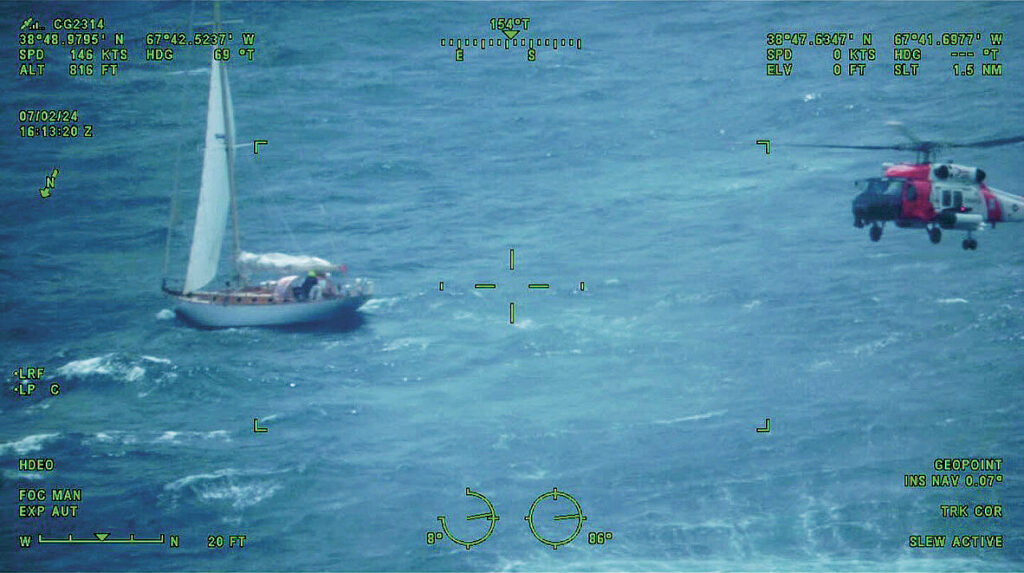
The Leak
Hearing water under the floorboards, he opened the engine compartment and saw water quite deep. He turned on the automatic bilge pump, then went through the whole boat checking through-hull fittings; all were intact, and he saw no other obvious signs of damage. By the time he was finished—about half an hour, he estimates—he checked the bilges again expecting to see less water. But he found the opposite; the water had risen about 6 more inches and the second pump, higher up in the bilge and with a float switch, had come online. Both could pump 100 gallons per hour, neither was keeping up.
“And that’s when I thought, ‘My luck has run out,’ ” Carter says.
Trying to find the source of a leak in a double-planked hull is complicated because of the boat’s construction. Unlike a single-planked boat, where a popped seam is obvious, the double-planking makes it impossible to see an external sprung seam, and the water coming in will seep throughout the inner planking, entering the interior from multiple areas and further confounding attempts to locate the damage. Carter did not feel confident he could find the source, and even if he did, he didn’t feel confident he could successfully patch it.
At that point, he turned his attention to the next step. Using the sat phone, he called his brother, an experienced pilot and sailor, and asked him to notify the Coast Guard so he could keep on with damage control onboard. His brother called back with a number for Carter to call; it was the USCG, telling him that a helicopter and plane were en route from Cape Cod 200 miles away and to activate his EPIRB.
When the plane arrived it dropped a dewatering pump with a 400-foot floating rope, which in theory should have been easy to sail up to and grab to retrieve the pump. But it proved impossible with the sea state, wind, and the engineless Solution’s increasing sluggishness in answering the helm. They tried for over an hour with no success. By this time, the helicopter was on scene, and they told him they could hover and lower a pump directly to the boat.
“But if they do that, they won’t have time to take anybody back to Nantucket with them,” Carter says. “They’re there at the end of their fuel range, which we knew, and so, are you going to get on the helicopter, or you want them to drop the pump?”
The Decision
At this point, he had a crewmember with a likely concussion. The fuel lines could not be bled and the engine restarted until the seas and wind abated, not expected until late the next day. That meant the batteries would eventually not be able to run the pumps. The leak was an enigma. And he estimated the water, now covering the floorboards, was rising an inch every 10 minutes, perhaps two to six hours by the time it covered the batteries.
He didn’t hesitate.
“It was so instant that I just said it almost matter-of-factly on the radio, and my daughter, who’s been sailing with me her whole life, she was appalled,” he says. “She said, ‘We can fix this! You know, we’ve never been unable to fix anything. We can figure this out.’ ’’
He said to her, “If I were to let that helicopter go back without us, that would be the most reckless thing I’ve ever done in my life. And you know, you can’t say, ‘Will you come back in two hours?’ ’’
He ran, he says, “a million scenarios” through his brain, how he could possibly slow the situation down long enough to save the boat—heave to, take pressure off the hull, get the second pump and figure out how to use it, wait out the weather, restart the engine, proceed under power, the list went on.
“Maybe, you know, as I was thinking, if I were alone, I might try it,” he says. “But I’m not alone…And it just wasn’t even something I thought I could even think about. Thinking about it was like—insane.”
In the end, they followed the Coast Guard’s instructions, leaped overboard one at a time into the bright, sparkling sea, and waited for the rescue swimmer to pluck them up.
“The competence and coordination of the Coast Guard crew was, not surprisingly, as close to perfection as humans get,” he says. All returned home safely within hours. Later that evening, Libby said to him, “You were right. We did the right thing.”
The Aftermath
Six months later, Carter has no doubt that remains true. He has thought, in retrospect, that when the seas grew so violent near the Stream’s wall, he could have cracked off, sailed under jib alone off the wind, slowing their exit but putting less pressure on the boat. But with 20 years sailing Solution across oceans and full confidence in her abilities in all conditions, it didn’t cross his mind he’d need to. “I’ve been in that situation before…it had never really harmed the boat other than making us uncomfortable.”
Still, he adds, “You always learn from being in the Gulf Stream.”
But he doesn’t second-guess his decision—even though the boat, he later learned from the sat phone’s positions still pinging, stayed afloat for almost three days. He also calculated, later, that the batteries even submerged could likely have run the pumps for days—they had enough stored power.
None of that has changed his mind that he made the right choice.
“The calculation isn’t what are the odds of you saving the boat. The calculation is, are you going to take that bet?” he says. “That is a gamble. You’ve got a helicopter right there that’s going to take all of you right now home. Lives are saved, that’s guaranteed. And your other choice is to gamble that you can save the boat. Because right now the only thing on the table is saving the boat.
“I mean, it was a beautiful boat, fabulous boat, just was out of this world,” he says of Solution. “But that’s all it was, was a boat. It’s just a thing. As much as I loved it.”
Theory Versus Practice
Carter says most of what he experienced—from the weather to how the boat handled, from crew skills to Coast Guard response—was what he expected (the exception, of course, being the leak). One aspect that did surprise him was how difficult it was to retrieve the dewatering pump the Coast Guard plane dropped to Solution. The sea state, wind, and the boat’s sluggish response to the helm, without having the engine to assist, made it extremely time-consuming and difficult. And, he says, he wasn’t sure how he would get it onto the boat once he got it alongside—with a halyard, probably—and then how to run it once it was onboard. None of these things are covered in standard safety classes, and his experience has prompted the CCA to add this topic—retrieving and operating a Coast Guard-deployed pump—to their safety at sea seminars.
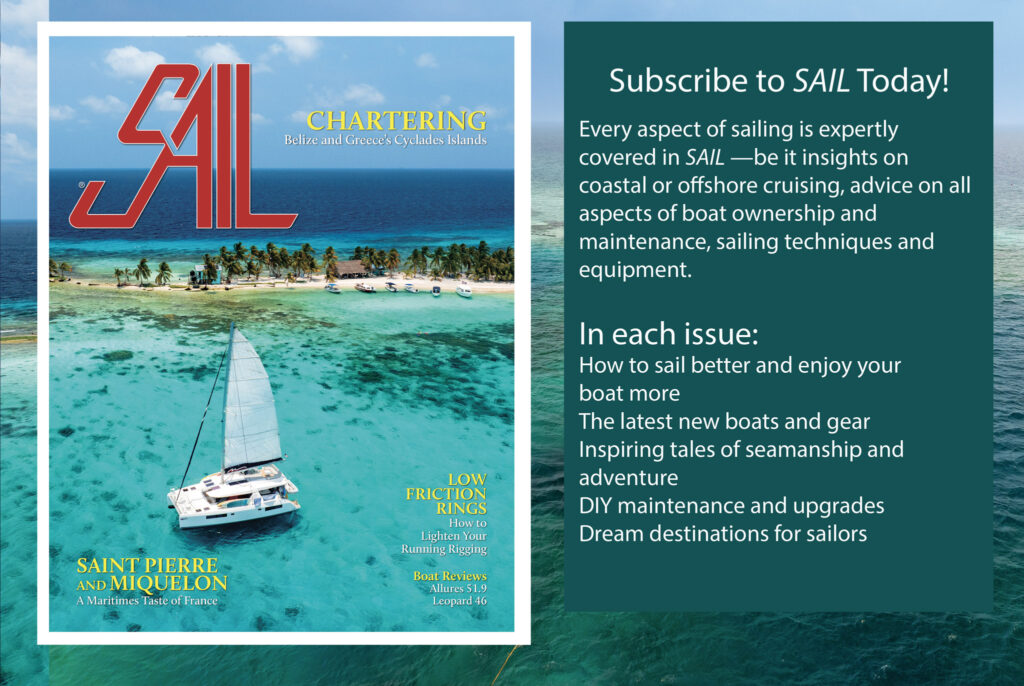
April 2025

